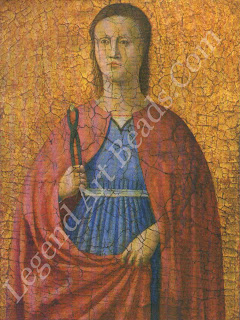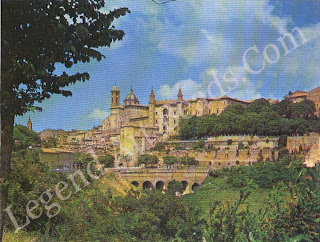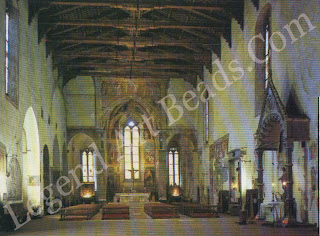Piero Della Francesca Artist life
Piero della Francesca is now perhaps the most revered
Italian painter of his period, but his great celebrity is fairly recent. In his
own day he was well known as a mathematician and theorist as well as a painter,
but by the 17th century he was almost forgotten, and it is only in the 20th
century that his severe purity of form and s consummate mastery of light and
colour have become fully appreciated.
The tardiness of Pieros elevation to the pantheon of great
artists reflects the restive obscurity of his career. Most of his life was
spent in the small town of Borgo san Sepolcro, and although commissions took
him to nearby 2: city-states, his work never had the exposure of that of ' many
of his great contemporaries. Now, however, his fresco cycle at Arezzo is
properly recognized as one of Italy’s greatest art treasures.
Sansepolcro's Famous
Son
Piero spent most of
his life in Sansepolcro, the little Tuscan town where he was born; but
prestigious commissions took him further afield, to some of the most illustrious
Renaissance courts.
Piero della Francesca was born between 1410 and 1420 in the
small town of Borgo san Sepolcro (nowadays known as Sansepolcro), some 40 miles
south-east of Florence. His father Benedetto, a tanner and boot maker, is said
to have died before the boy was born, and Giorgio Vasari's 16th-century life of
Piero tells us that he was brought up by his mother, Romana. She came from
nearby Monterchi, where the tiny chapel of the cemetery is decorated with
Piero's fresco of the Madonna del Parto (Virgin of Childbirth,). The picture's
subject makes it a fitting homage to the artist's mother, who may well have
been buried at her birthplace.
LITTLE DOCUMENTATION
We have no record of Piero's early years, and few documents
from any period of his life. In 1442, and again in 1467, he was elected a town councilor
at Sansepolcro, and over the years he carried out several commissions for
paintings there. It was at Sansepolcro that he made his will, and he died
there, the town celebrity, in 1492. Piero clearly loved his birthplace,
returning there all through his life. Features of the town and its surrounding
countryside appear in a number of 1250
His paintings. But the search for wider artistic experience,
and the quest for commissions, took him further afield, to the Papal court at
Rome and to the towns and city-states of Florence, Ferrara, Rimini and Urbino.
It is in Florence that we first hear of him, working with the painter Domenico
Veneziano on the fresco decoration of the church of Sant'Egidio (now
destroyed). The record, dated 7 September 1439, does not make it clear whether
or not Piero was still learning his trade as Domenico's assistant.
A young man of
Piero's gifts would in any case have found plenty to instruct and excite him in
Florence. Having defeated its great rival, Pisa, the city was at the zenith of
its power. In the midst of its vivid artistic and intellectual life, Piero
absorbed the influence of such painters as Gentile da Fabriano, who worked in
the florid International Gothic style, and Masolino and Masaccio, whose
frescoes must have impressed Piero with their grave monumentality.
The artist would also have heard excited discussions on the
new theories of perspective, set forth in Leon Battista Alberti's treatise on
painting, Della Pittura. Piero went on to become a renowned master of
perspective to the architect Bramante and writing a work of his own entitled De
prospection pingendi (on perspective in paintings)
A BYZANTINE DIGNITARY
One public event that took place during his stay in Florence
seems to have made a strong impression on Piero. In 1439, John Paleologus, the
Byzantine Emperor, arrived in the city from Constantinople. He had travelled to
Italy with the dignitaries of the Eastern Church in search of Christian unity against
the Turks. At the Council of Florence, agreement between the two Churches was
solemnly proclaimed. It was to prove short-lived, and the capture of
Constantinople by the Turks in 1453 cast a shadow over the mid-century and led
to calls for a new Crusade. This theme is later invoked in Piero's Flagellation
where the bound figure of Christ can be seen as a symbol of the Eastern
Christians who were suffering at Turkish hands.

In 1439, of course,
all this lay in the future. Both the spectacle of the Emperor and his retinue,
with their sumptuous and exotic garments, deeply impressed the Florentines. The
splendour of Piero's Solomon Receiving the Queen of Sheba part of his great
fresco-cycle at Arezzo shows that the memory was still fresh 15 years after the
event.
From Florence, Piero
returned to his native town, where in 1445 he was given his first recorded
commission, for the polyptych known as the Misericordia Altarpiece Only partly
by Piero's own hand, this seems to have taken an inordinate time to complete;
the final payment for it may have been made as late as 1462. A slow and
meticulous worker, Piero was also often called away to work for other patrons.
Some time before
1450, he visited Ferrara. Although no trace of his work remains, his influence
on later Ferrarese art is unmistakable. The court of the d'Este family at
Ferrara was de-voted to the crafts of war and hunting, the love of pleasure,
the intrigue of dynastic politics, and the pursuit of learning and the arts.
Here, Piero would have seen the works of the great Netherlandish painter,
Rogier van der Weyden, who had probably stayed at the d'Este court the previous
year.
THE TEMPLE OF
MALATESTA
Piero was next called to Rimini, where the notorious
Sigismondo Malatesta obtained his help in the ambitious redecoration of the
Church of San Francesco, known as the Tempio Malatestiano (Temple of
Malatesta). Piero's contribution, a
Fresco showing Malatesta kneeling in veneration of his
patron saint, Sigismund, is notable in being his only dated work - inscribed
1451.
Piero also worked for Malatesta great rival
Federigo da Montefeltro, whose model court at Urbino was a famous centre of
humanist learning and the arts. Piero travelled there many times between 1450
and 1480, and his Urbino pictures include two of his best-known works, The
Flagellation of Christ and the striking diptych (now in the Uffizi, Florence),
which shows Federigo and his wife, Battista Sforza, in profile against a
luminous landscape of lightly wooded hills and pale tranquil water In the early
1450s Piero began work on his largest commission, the Arezzo frescoes.
The
Bacci family, wealthy merchants of the town, had entrusted the decoration of
their chapel in the church of San Francesco to Bicci di Lorenzo, a Florentine
painter of the old school. When Bicci died in 1452, before he had begun work on
the walls, Piero was called in, and together with his assistants spent most of
the next 12 years on the task. In 1459 he visited the Papal court at Rome to
decorate the chamber of Pius I (his work, writes By 1466 the Arezzo cycle was complete. Although many
important paintings still lay before him, Piero was never to work on so large a
scale again. Some critics have suspected a loss of enthusiasm in these later
years, but such a picture as the National Gallery Nativity -
unquestionably a late work - hardly shows lack of inspiration.
BLIND IN OLD AGE

Tradition holds that Piero lost his sight in old age. A lantern-maker
of Borgo san Sepolcro, Marco di Longaro, told a 16th-century memoirist that as
a boy he used to 'lead about by the hand Master Piero Della Francesca,
excellent painter, who was blind'. Be that as it may, Piero was able to declare
himself 'sound in mind, in intellect and in body' as late as 1487, when he
wrote his will in his own hand. Unmarried and without children, he left his
property to his brothers and their heirs. Five years later, he died, and was
buried in the family grave in the Abbey of Sansepolcro. The record of his death
can be seen in the Palazzo, now the town museum and art gallery, where his
superb painting of the Resurrection still hangs today: 'M. Pietro di
Benedetto de 'Franceschi, famous painter, on 12 October 1492.'
Writer-Marshall Cavendish
 Tradition holds that Piero lost his sight in old age. A lantern-maker
of Borgo san Sepolcro, Marco di Longaro, told a 16th-century memoirist that as
a boy he used to 'lead about by the hand Master Piero Della Francesca,
excellent painter, who was blind'. Be that as it may, Piero was able to declare
himself 'sound in mind, in intellect and in body' as late as 1487, when he
wrote his will in his own hand. Unmarried and without children, he left his
property to his brothers and their heirs. Five years later, he died, and was
buried in the family grave in the Abbey of Sansepolcro. The record of his death
can be seen in the Palazzo, now the town museum and art gallery, where his
superb painting of the Resurrection still hangs today: 'M. Pietro di
Benedetto de 'Franceschi, famous painter, on 12 October 1492.'
Tradition holds that Piero lost his sight in old age. A lantern-maker
of Borgo san Sepolcro, Marco di Longaro, told a 16th-century memoirist that as
a boy he used to 'lead about by the hand Master Piero Della Francesca,
excellent painter, who was blind'. Be that as it may, Piero was able to declare
himself 'sound in mind, in intellect and in body' as late as 1487, when he
wrote his will in his own hand. Unmarried and without children, he left his
property to his brothers and their heirs. Five years later, he died, and was
buried in the family grave in the Abbey of Sansepolcro. The record of his death
can be seen in the Palazzo, now the town museum and art gallery, where his
superb painting of the Resurrection still hangs today: 'M. Pietro di
Benedetto de 'Franceschi, famous painter, on 12 October 1492.'

















0 Response to "Introduction to Piero Della Francesca Artist life"
Post a Comment